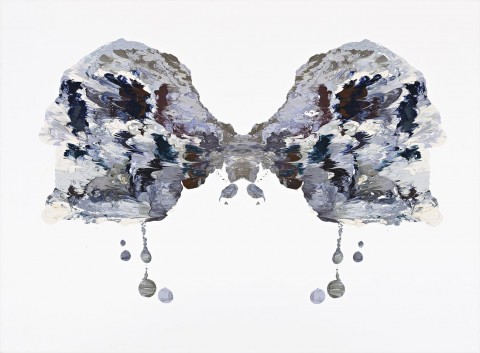SKULL RORSCHACH, 2007
BEN QUILTY
oil on linen
140.0 x 190.0 cm
GrantPirrie Gallery, Sydney
Private collection, Sydney, acquired from the above in 2007
Slade, L. (ed.), Ben Quilty, University of Queensland Art Museum, Brisbane, 2009, p. 125 (illus.)
Over several decades Ben Quilty has created an impressive body of work, each painting and sculpture grappling with the emblems of Australian mateship, the toxic inheritance of colonial inequality and the pervasive lack of empathy in contemporary society. Amongst these, Skull Rorschach, 2007, is a potent reminder of the fleeting nature of human life. The ancient motif of a human skull has been often appropriated in contemporary art, becoming an emblem for an uncertain and reckless society.
Painted on a single, pristine canvas, the mottled form of Skull Rorschach proudly displays its mode of production. The symmetrical composition centered around a vertical axis has been borrowed from the iconic inkblots of Swiss psychologist Herman Rorschach’s pseudoscientific test of mental /visual association. In rich, trowelled swathes Quilty painted a skull, whose negative impression was then transferred to the left side of the canvas while the paint was still wet (the canvas presumably being subsequently stretched over the frame). While Quilty’s first experiments with Rorschach methods were limited to symmetrically opposing images over two canvases of the same size, Skull Rorschach is more sophisticated, with the central motif isolated within a tight and dynamic composition. By incorporating an almost Dada automatic adulteration of his painted surface into the finished artwork, Ben Quilty creates a strong association between his method of painting and the reckless abandon with which he and his mates lived their early 20s in the suburban outskirts of Sydney. Beyond its marbled surface, marshalled into focus by attentive viewers, two skulls surge forward – their streaked surfaces giving the disorienting impression of great velocity – tempus fugit!
Delighting in the happy accidents of the painted (and printed) surface, Quilty is attentive to a range of new aesthetic possibilities. A cautionary reminder for Quilty and his washed-up mates, the series of disembodied skulls directly followed his 2007 series of grimacing faces and massive, fallen heads. A human skull, often adorned with fangs or pistols and surrounded by intertwined snakes, became a clear and powerful visual motif for Quilty to use as a basis for painterly experimentation. It led to a large series of painted works between 2005 and 2010, most featuring the artist’s signature chromatic palette of lilac, pink, grey and khaki. While some works of this series were given leading titles that encouraged a socio-historical reading, such as Bedford Downs Rorschach and It was Dark When, this stark Skull Rorschach makes no allusion to anything beyond a simple memento mori. With the base of each skull butted against the other, they face outward, Janus-faced, contemplating simultaneously the past and the future. Janus, the two-faced Roman deity, presided over the beginning and ends of conflict, time and in particular moments of transition – a fitting symbol for Quilty’s art of this period, the high- energy cultural milieu of mateship, bravado and perpetual flirting with self-destruction. With a visceral appreciation of the unctuousness of paint, teetering here on the verge of abstraction, Quilty activates our senses, engaging the viewer to relate two messages – a) that we are currently alive, and b) it won’t last.
LUCIE REEVES-SMITH
